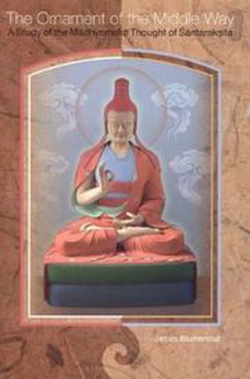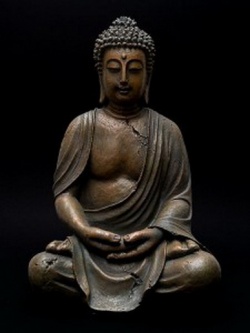Introduction: Buddhism and Science—Breaking Down the Barriers by B. Alan Wallace
The publication of a volume of essays on Buddhism and science presupposes that these two fields are commensurable and that the interface between Buddhist theories and practices and scientific theories and modes of inquiry can somehow be fruitful. But serious objections to this presupposition can be raised from the outset, so I would like to introduce this work by presenting arguments against such a coupling of Buddhism and science together with my responses to those arguments. The first idea to be considered is the view that religion and science are autonomous, their domains of concern mutually exclusive, so they really have little, if anything, to say to each other. I shall respond to this assertion by first analyzing whether Buddhism can properly be categorized according to modern Western notions of religion , then I shall describe specific elements within Buddhism that may be deemed scientific . I shall then distinguish between empirical science itself and the metaphysical dogma of scientific materialism that is often conflated with it. Next I shall address objections raised by proponents of postmodernism, to the effect that Buddhism and science are cultural specific and hence fundamentally incomparable. Finally, I shall present suggestions for a dialogic approach to the study of Buddhism and science that may enrich both fields and consequently broaden our understanding of the subjective and objective domains of the natural world .
ARE RELIGION AND SCIENCE AUTONOMOUS?
Most mainstream religious thinkers and many scientists share the view of religion and science as independent and autonomous rather than conflicting realms , with each discipline having its own domain and methods that can be justified on its own terms. One of the most prominent scientists to promote this view is paleontologist Stephen Jay Gould. In his book Rocks of Ages: Science and Religion in the Fullness of Life Gould argues that religion and science are logically distinct and fully separate in terms of their styles of inquiry and goals. But, rather than suggesting that they are irrelevant to each other, he emphasizes the need to integrate insights from both in order to build a rich and full view of life (Gould 1999:29). One of Gould’s central ideas is that the domains of religion and science consist of “non-overlapping magisteria.” In his view the magisterium of science includes the empirical realm, and it addresses the questions of what the universe is composed of and how it works. The magisterium of religion, on the other hand, consists of the realm of human purposes, meaning, and value. His solution for the apparent conflicts between religion and science is to maintain that the two should coexist in a spirit of respectful noninterference. Religious texts, therefore, should not be read as scientific texts, and the claims of scientists should not be used to disprove the basis of religious belief (93).
In a similar vein, theologian Langdon Gilkey declares that religion addresses questions concerning the meaning and purpose of life , our ultimate origins and destiny , and the experiences of our inner life. Science , in contrast, seeks to explain objective, public, repeatable data with theories that are logically coherent and experimentally adequate, presenting quantitative predictions that can be tested experimentally (Gilkey 1985:108–116).
Not all scientists (or religious believers), however, go along with the amicable assertion of the nonoverlapping domains of religion and science. Zoologist Richard Dawkins, for example, poignantly argues that religious beliefs are not outside the domain of science and there are consequently irreconcilable differences between religion and science. Since religions do make claims about the nature of existence, and do not confine themselves solely to questions of meaning and values, religious beliefs and dogmas should be subjected to scientific criticism (Dawkins 1999:62–64).
Sociobiologist Edward O. Wilson takes a somewhat more equivocal position regarding the relation between religion and science. He first defines science as the “organized, systematic enterprise that gathers knowledge about the world and condenses the knowledge into testable laws and principles” (Wilson 1998:58). This, he claims is the accumulation of humanity’s organized, objective knowledge and is the first medium devised able to unite people everywhere in common understanding. Religion he defines as
- “the ensemble of mythic narratives that explain the origin of a people, their des- tiny, and why they are obliged to subscribe to particular rituals and moral codes” (247).
At first glance Wilson seems to follow Gould’s premise of nonoverlapping magisteria. He suggests that the proper role of religion is to codify and put into enduring, poetic form the highest values of humanity consistent with empirical knowledge . And the responsibility of science is to test relentlessly every assumption about the human condition, thereby eventually uncovering the bedrock of the moral and religious sentiments. This appears to be an affirmation of the familiar fact/value split between science and religion . He even bemoans the tragedy it would be if the United States , for example, were to abandon its sacral traditions . For example, even the most secular Americans would be ill advised, he admonishes, to expunge “under God ” from the American Pledge of Allegiance; oaths should continue to be taken with hand on the Bible; everyone should bow their heads in communal respect as ministers and rabbis bless civil ceremonies with prayer .
In apparent agreement with Dawkins, Wilson’s scheme of consilience, or the grand unification of knowledge , requires that all religious truth claims be subjected to empirical testing using the methods of objective scientific inquiry. Thus the existence of God is a problem for astrophysics, and the nature of the human mind and soul is to be determined at the juncture of biology and psychology, in terms of nerve cells, neurotransmitters, hormone surges, and recurrent neural networks. Only in this way, he declares, can humanity discover which cellular events compose the mind (241,99–100). In this way religious narratives about the nature of the universe and humanity will be replaced by scientific theories that possess “more content and grandeur than all religious cosmologies combined” (265). In the final analysis, he claims, belief in the gods and belief in biology are not factually compatible. “As a result those who hunger for both intellectual and religious truth will never acquire both in full measure” (262). The implication of his view seems to be that society should maintain the rituals suggestive of belief in a fictitious God without attributing any more reality to God than is granted to Santa Claus or the Easter Bunny.
All the above views have profound implications for the interface between Buddhism and science , assuming that Buddhism can be categorically regarded as simply a religion. Let us now turn to the important question of whether this common classification is justified.
IS BUDDHISM SIMPLY A RELIGION?
Whether we categorize Buddhism as a religion depends, of course, on our definition of the word religion. According to religionist Van Harvey , we deem a system of belief and practice to be religious if it expresses a dominant interest in certain universal and elemental features of human existence as those features bear on the human desire for liberation and authentic existence (Harvey 1981:chapter 8). So defined, Buddhism may indeed be viewed as a religion . On the other hand, according to the above definition suggested by Edward Wilson, Buddhism does not as a whole neatly fit the criteria of a religion . Its core is the Four Noble Truths : the truths of suffering , the sources of suffering , the cessation of suffering together with its source, and the path to such cessation . This has little to do with any “mythic narratives that explain the origin of a people, their destiny , and why they are obliged to subscribe to particular rituals and moral codes.”
Wilson’s assumptions and speculations about religion , expressed in his book Consilience, are evidently based almost entirely on the Judeo-Christian tradition , while ignoring the specific features of all other religious traditions throughout the world . Considering the wealth of information we now have in European languages about all the major religious traditions of the world , this oversight seems unjustified. But this form of ethnocentricity is unfortunately quite common, even in the contemporary academic study of religion. Religionist Richard King cites the long tradition in Western Orientalist scholarship to uncritically bring Christian assumptions about the nature of religion to bear on Buddhism. Academic Buddhologists have traditionally regarded Asian Buddhists as “native informants,” and involvement with them, he writes, was usually subordinated to the insights to be gained from careful reading of the “canonical ” works of ancient Buddhists . This was seen as the most effective way to discern the true essence of Buddhism. The consequence of this trend was that “pure” or “authentic Buddhism” became located not in the experiences, lives or actions of living Buddhists in Asia but rather in the university libraries and archives of Europe—specifically in the edited manuscripts and translations carried out under the aegis of Western Orientalists. (King 1999:150)
To understand Buddhism on its own terms, it is imperative that we in the West recognize the cultural specificity of our own terms religion , philosophy , and science and not assume from the outset that Buddhism will somehow naturally conform to our linguistic categories and ideological assumptions. Buddhism clearly includes profoundly religious elements, as outlined by Harvey, as well as strong philosophical themes and reasoning from its inception. Most important for the theme of this volume, it has also, from its very origins, established rigorous methods for experientially exploring the personal and impersonal phenomena that make up the natural world . Such techniques, many of which are designated by the English term meditation , frequently entail careful observation followed by rational analysis. In short, there are elements of Buddhist theory and practice that may be deemed scientific , but in flatly classifying Buddhism as a religion both its philosophical and scientific features are simply overlooked.
Such ideological hegemony crops up frequently in the writings of Western Buddhologists to the present day. For example, Buddhologist Luis Gómez characterizes Buddhist doctrine simply as a “religious ideology,” which stands in opposition, he suggests, to any form of rational public discourse (Gómez 1999:369). As indicated in many of the records of Buddha ’s own teachings, as well as the eminent history of Buddhist dialectics and public debate in India and Tibet in particular, many Buddhist theories are obviously expressions of rational public discourse. The notion that only nonreligious people have some kind of a monopoly on such discourse is simply untenable. Moreover, Buddhists have a long tradition of studying the mind and presenting rational descriptions of its functions and ways of healing its afflictions and developing wholesome mental behavior. Yet Gómez expresses his bafflement upon encountering the term Buddhist psychology on the grounds that such a word is no more justified than Christian chemistry. By drawing a spurious parallel between Buddhist psychology and Christian chemistry, Gómez dismisses the rapidly increasing number of essays and books on Buddhist psychology and its relation to modern psychology written by psychologists and Buddhist scholars alike. No one, on the other hand, is seriously suggesting that there is such a thing as Christian chemistry. His reasoning here seems to be that Buddhists lack the tools and methods of modern Western psychology, so whatever methods for studying the mind and whatever conclusions they may have drawn cannot be deemed psychological . This same line of reasoning is the one used for excluding Buddhist philosophy from virtually all academic departments of philosophy in Europe and America: if Buddhists don’t philosophize following the same rules as Western philosophers , they don’t philosophize at all. But if we should follow this line of reasoning ad absurdam, since Buddhism does not even affirm the existence of a divine Creator who rules the universe , punishes sinners, and rewards the faithful, like the “genuine” religion of Christianity, it can’t even be counted as a religion . It simply falls through the cracks and counts for nothing at all.
It is true that Buddhism fails to fit neatly into any of our categories of religion , philosophy , and science , for the simple reason that it did not develop in the West, where these concepts originated and evolved. Buddhism offers something fresh and in some ways unprecedented to our civilization, and one of its major contributions is its wide range of techniques for exploring and transforming the mind through firsthand experience. But many scholars of religion , including Buddhologists, appear incapable of imagining that the Buddhist tradition may have developed ways of knowing that have not already been developed in the West. Gómez, for instance, refers to Buddhist meditations as forms of “ritualized behavior” that are “rehearsed” in the hopes that “conforming” to such conduct will transform oneself and others in favorable ways (368). Buddhologist Roger R. Jackson similarly portrays Buddhist meditation as a type of ritual act (Jackson 1999:231). While such characterizations are certainly valid for some types of Buddhist meditation , they are profoundly misleading for the practices of meditative quiescence (´samatha) and contemplative insight (vipa´syana¯), which are the two core modes of Buddhist meditative training. Techniques of meditative quiescence entail the rigorous cultivation of attentional stability and vividness, methods having a strong bearing on William James’s psychological theories of attention (Wallace 1998,1999a). And the wide range of Buddhist techniques for the cultivation of contemplative insight , based upon the prior training in refining the attention, also bear great relevance to modern theories of clinical and cognitive psychology.
What many Buddhologists seem to do is stuff Buddhism into familiar files, such as “religion ” or “philosophy ,” without attending closely to the ways in which it does not fit our Western categories. Having comfortably classified Buddhism in ways that do not challenge any of their preconceptions about religion , philosophy , or science , they conceive of the great proponents of traditional Buddhism over the ages in their own image: as scholars who spent their time reading other people’s books and writing their own books about other people’s books. While contemporary Buddhologists may be validly regarded as professional scholars of Buddhism , few consider themselves, or are considered by others, as professional contemplatives within the Buddhist tradition . This contrast between scholarly professionalism and contemplative inexperience has introduced a glaring bias into modern academic Buddhist scholarship (Wallace 1999b).
A flagrant example of this trend occurs in the writings of religionist Paul Griffiths. In his extensive writings on the nature and goals of Buddhist meditation , Griffiths candidly acknowledges that in terms of his own methodology he does not even begin to address whether or not there actually are or were virtuoso Buddhist practitioners who claim to be able to enter the meditative state called “the attainment of cessation ” (nirodhasama¯patti), which is a primary goal of Buddhist meditation . On the basis of his text-critical analysis of the attainment of this meditative state, he concludes that it is analogous to “some kind of profound cataleptic trance, the kind of condition manifested by some psychotic patients and by long-term coma patients” (Griffiths 1986:11). Having drawn this conclusion, he does not speculate on why Buddhist contemplatives would undergo long years of training in philosophy (Wallace 1980), ethical discipline , attentional refinement, and experiential, contemplative inquiry just to achieve a state that could more readily be achieved through a swift blow to the head with a heavy, blunt instrument. This is the type of absurd conclusion that emerges from the Orientalist approach taken by so many Buddhologists since the inception of this Western academic discipline (Almond 1988; Wallace 1999c). What is most odd about this approach is that it is somehow deemed by its advocates to be scientific . On the contrary, modern science emerged in part as a rebellion against just this kind of nonempirical, dogmatic, scholastic mode of inquiry!
Regardless of the commonly unscientific study of Buddhism in Western academia, the question remains whether elements of Buddhism itself may be considered scientific in some meaningful sense of the term. Wilson accurately describes science as the “organized, systematic enterprise that gathers knowledge about the world and condenses the knowledge into testable laws and principles” (58). This enterprise is centrally concerned with the networks of cause and effect across adjacent levels of organization, and it is characterized by an empiricism that stands in stark contrast to the transcendentalism that lies at the core of so much philosophy and theology.
Returning to the core theme of Buddhist theory and practice—the nature and causal origins of suffering , the possibility of freedom, and the causes that lead to such freedom—we see that Buddhism too is centrally concerned with causality within human experience. In this sense it is a form of naturalism, not transcendentalism. Buddhism , like science , presents itself as a body of systematic knowledge about the natural world , and it posits a wide array of testable hypotheses and theories concerning the nature of the mind and its relation to the physical environment. These theories have allegedly been tested and experientially confirmed numerous times over the past twenty-five hundred years, by means of duplicable meditative techniques (Wallace 2000:103–118). In this sense, too, Buddhism may be better characterized as a form of empiricism rather than transcendentalism. This is not to deny, of course, the diversity of views among Buddhists about the nature and significance of specific contemplative insights, rather, over the history of science , in each generation, its theories and discoveries have also been open to varying interpretations. A major difference between science and Buddhism is that scientists largely exclude subjective experience from the natural world and attribute causal efficacy only to physical phenomena . Buddhism , in contrast, takes subjective mental phenomena at least as seriously as objective physical phenomena and posits a wide range of interdependent causal connections between them.
To take a specific example, to a much greater extent than modern psychology Buddhism presents rigorous means of investigating the necessary and sufficient causes of suffering and happiness . It is intent not only on counteracting suffering once it has arisen but on identifying and counteracting the causes of suffering before it arises. All conditioned phenomena arise from multiple causes, and the central theme of Buddhism is to identify especially the inner causes of joy and sorrow, for they have been found to be more crucial than outer, physical causes. This is perhaps the most scientific aspect of Buddhism , and it addresses issues in the realm of human experience and consciousness itself that have been largely overlooked by modern science . Surely it is unscientific to declare that humans are prone to dissatisfaction simply because of “human nature,” as is commonly assumed in modern psychology!
Buddhist insights into the nature of the mind and consciousness are presented as genuine discoveries in the scientific sense of the term: they can be replicated by any competent researcher with sufficient prior training. But are the means by which these alleged discoveries have been made truly rigorous? They are certainly not quantitative, nor do they lead to the formulation of mathematical laws. But the criteria of rigor in one field, such as the exploration of objective physical processes, may be superfluous or inapplicable in another, such as the exploration of subjective experience and its relation to the environment. Whether a method is deemed rigorous or not depends on what one is trying to achieve. In some contexts precise quantitative measurement is crucial to rigorous observation, in others it is impossible or irrelevant. In such cases new criteria of rigor need to be devised in relation to the specific epistemic and pragmatic goals of the research.
One distinction commonly made between science and the contemplative traditions of the world is that science entails collective knowledge , whereas contemplative insights are always private and cannot be shared. As Edward Wilson, points out, “One of the strictures of the scientific ethos is that a discovery does not exist until it is safely reviewed and in print” (59). What he means, of course, is that a discovery is not accepted within a scientific community until it has been published and acknowledged . This valid assertion cannot refute the obvious fact that a genuine discovery actually takes place prior to its publication! And even after it is published a scientific discovery can normally be validated only by a relatively small number of experts within a specific field of research. Other scientists and the general public will, for the most part, accept the discovery on the basis of their faith in the experts. This situation is not so different from discoveries made by Buddhist contemplatives. The discoveries are made in terms of their own firsthand experience. They may then be reported either verbally or in print, and their claims are subject to peer review by their fellow contemplatives, who may debate the merits or defects of the reported findings. Critiques by anyone other than professional contemplatives are taken no more seriously than critiques of scientific theories by nonscientists.
The assertion that Buddhism includes scientific elements by no means overlooks or dismisses the many explicitly religious elements within this tradition . As Stephen Jay Gould says of religion , Buddhism is very much concerned with human purposes, meaning, and value. But, like science , it is also concerned with understanding the realms of sensory and mental experience, and it addresses the questions of what the universe , including both objective and subjective phenomena , is composed of and how it works. In accordance with Langdon Gilkey ’s portrayal of religion , Buddhism does address questions concerning the meaning and purpose of life , our ultimate origins and destiny , and the experiences of our inner life . But the mere fact that Buddhism includes elements of religion is not sufficient for singularly categorizing it as a religion , any more than it can be classified on the whole as a science . To study this discipline objectively requires our loosening the grip on familiar conceptual categories and preparing to confront something radically unfamiliar that may challenge our deepest assumptions. In the process we may review the status of science itself, in relation to the metaphysical axioms on which it is based.
EMPIRICAL SCIENCE AND THE DOGMA OF SCIENTIFIC MATERIALISM
In this presentation of the salient features of science and scientific materialism, I shall refer frequently to the writing of Edward Wilson, who is both a distinguished scientist as well as an articulate, self -avowed proponent of scientific materialism and scientism. The extent to which I dialogue with Wilson in this introduction may seem incommensurate with the fact that he has so little to say about Buddhism . But scientific materialism as he so well presents it is widely accepted by many scientists and nonscientists, and it is this dogma in general that presents formidable obstacles to any meaningful collaboration between Buddhism and science . Wilson points out five diagnostic features of science that distinguish it from other modes of inquiry (53). 1. The first feature is repeatability, which is characteristic of experiments in which the phenomena under study can be controlled. But this is rarely possible in sciences such as astronomy, where the Scientific Revolution began, and geology, so it is not true of all the natural sciences. 2. The second feature is economy, namely, the abstraction of knowledge in the simplest and most aesthetically pleasing way possible. While simplicity may be an objectively measurable quality, beauty is not. At this point Wilson rightly points to an obviously subjective element in the formulation of scientific theories. 3. The third feature is mensuration, which is to say that science focuses on things that can be measured using universally accepted scales. While quantitative measurements are perfectly appropriate for objective, physical phenomena , their application is less feasible for the scientific study of subjective mental phenomena . This leaves science with two options: (a) either to exclude subjective experience from the domain of science , or (b) to acknowledge that the concept of rigorous measurement must be reappraised when studying the mind . 4. The fourth feature is heuristics, which means that the best science stimulates further discovery. The implication, of course, is that if a scientific dogma inhibits further discovery it should be expelled from scientific thinking . 5. The final feature cited by Wilson is consilience, meaning that the scientific explanations that survive are those that can be connected and proved consistent with one another. If consilience is truly to unify all aspects of the natural world , as he envisions, it must include the empirical study of subjective experience as well as objective phenomena , but Wilson offers no strategy for unifying both these elements of the natural world .
Like most other scientific materialists, Wilson conflates empirical science with the metaphysical assumptions of scientific materialism, but I shall now argue that the latter is actually a type of dogma that has long impeded discoveries especially pertaining to the mind and consciousness . By the term dogma I mean a coherent, universally applied worldview consisting of a collection of beliefs and attitudes that call for a person’s intellectual and emotional allegiance. A dogma , therefore, has a power over individuals and communities that is far greater than the power of mere facts and factrelated theories. Indeed, a dogma may prevail despite the most obvious contrary evidence, and commitment to a dogma may grow all the more zealous when obstacles are met. Let us now turn to some of the fundamental assumptions of the dogma of scientific materialism.
Objectivism
As a metaphysical dictate the principle of scientific objectivism requires one to disregard that which is individual, private, uncontrolled, unique, and anomalous. Even though such events occur frequently in the natural world , they are not included in the scientific picture of reality and so are not regarded as real. Thus, with a single metaphysical stroke of the pen, subjective experience is written out of nature and consigned to the status of an epiphenomenon or illusion . The affirmation of scientific objectivism also implies a commitment to the view that, in Wilson’s words, “outside our heads there is freestanding reality . . . . Inside our heads is a reconstitution of reality based on sensory input and the self -assembly of concepts” (60–61). The proper task of scientists , he claims, is to correctly align the subjective representation of reality inside our heads with the objective external world . What this implies, then, is that the objective world lies beyond the subjective world of appearances, including all the evidence from our senses , which exists only in our heads. Wilson correctly acknowledges that there is no objective yardstick on which to mark the degree of correspondence between the objective world and our subjective representations (59). Therefore, as much as he tries to promote empiricism, in opposition to transcendentalism, he is in fact a transcendentalist with respect to the very existence of the objective world and our knowledge of it. For the “real world ,” which is the domain of science as he understands it, transcends all empirical data and can be known only indirectly, by way of the representations inside our heads. While admitting that contemporary science has no criteria of objective truth , Wilson places his faith in future discoveries in the brain sciences, which he hopes will reveal the physical bases of thought processes and thereby reveal the nature of the mind itself (Wilson 1998:60, 64).
Reductionism
Wilson places great store in the principle of reductionism, which he describes as the cutting edge of science that breaks nature apart into its natural constituents. As a research strategy, reductionism has proved its usefulness countless times in the history of science . But this guideline must be used wisely. In the brain sciences, for example, if one focuses one’s attention on the operations of individual subatomic particles, atoms, molecules , cells, or even entire ganglia of neurons, this excessively narrow vision can obstruct insight into the global processes occurring in diverse regions of the brain. Moreover, if one focuses solely on objective brain functions and ignores subjective mental events, this mode of reductionism prevents one from discovering mind -brain correlates. All one learns about is the brain, which, by itself, reveals no objective evidence for the existence of consciousness or subjective experience of any kind! Thus, if one dogmatically assumes that the mind is composed of nothing more than brain functions, as Wilson does, this fixation ensures that the mind , as it is experienced firsthand, will remain a mystery . And if all our representations of the objective world exist only in our minds , this type of reductionism also leaves the objective world a transcendent mystery . In other words, Wil son’s commitment to ontological reductionism seems to undermine his whole ideal of consilience.
Monism
Scientific materialists appear to be in wholehearted agreement that the entire universe fundamentally consists of one kind of stuff, and that is matter. Any divergence from this view, they claim, brings us inevitably back to an antiquated, discredited form of Cartesian dualism , which posits the existence of two primary kinds of substances: mind and matter. But why should we limit our imaginations to these two options alone? Consider the ontological status of numbers, including real numbers such as the gravitational constant and Planck’s constant, as well as imaginary and complex numbers, mathematical laws, space, time, ideas, sensory and dream imagery , and consciousness . Why should we believe that all such phenomena really consist of one type of stuff? Why could the natural world not be comprised of a wide range of material and immaterial phenomena ? Only the dogmatic principle of monism prevents us from considering other possibilities.
Physicalism
The research instruments of science , since the time of Galileo, have been designed to measure physical phenomena only. Thus if other types of phenomena exist, they must lie outside the domain of science as it has developed thus far. Advocates of the metaphysical principle of physicalism, however, have concluded that only those phenomena that can be detected with the tools of science actually exist. The universe is believed to consist solely of matter and its emergent properties. To understand this principle, it is crucial to recognize that the matter in question is not the familiar stuff that we bump into in everyday experience. A rock held in the hand, for instance, is experienced as having a certain color, texture, and weight. But all those qualities are secondary attributes that exist, according to Wilson, not in the objective world but as representations inside our heads. The matter that is the fundamental stuff of the objective universe , according to scientific materialism, exists independently of all such secondary attributes that arise only in relation to a conscious subject. The real properties of matter are its inherent primary attributes that exist independently of all modes of detection.
What does science know today about the nature of matter? Physicists agree that matter consists of atoms, which in turn are made up of elementary particles such as electrons and protons. There are then further speculations concerning quarks, superstrings, and so on with regard to the component parts of elementary particles. But the actual nature of these fundamental building blocks of the universe is somewhat shrouded in mystery . Some physicists argue that atoms are emergent properties of space or space-time. But which space are they referring to? There are actually countless possible spaces with their own geometries, each of which is equally valid and self -consistent. Others maintain that atoms are not things at all but are better viewed as sets of relationships (Wallace 1996:55).
Even if matter is regarded as some independent stuff existing independently in the objective universe , its mass and spatial and temporal dimensions are not fixed or absolute but, according to relativity theory, depend upon the inertial frame of reference from which they are measured. And, in terms of quantum mechanics, it appears increasingly dubious whether the elementary particles of matter have any discrete location independent of all systems of measurement. Ever since the origins of quantum mechanics experts have expressed diverse views, ranging from the assertion that elementary particles exist independently as real, distinct entities to the view that there is no objectively existing quantum realm at all (Herbert 1985)! As physics continues to progress, the primary status of matter appears to be on the decline. As physicist Steven Weinberg recently commented, “In the physicist’s recipe for the world , the list of ingredients no longer includes particles. Matter thus loses its central role in physics. All that is left are principles of symmetry” (Cole 1999).
Upon confronting such startling lack of consensus about the nature and primacy of matter, the physicalist may take refuge in the notion of energy and its conservation as the primary stuff of the universe . But, once again, one is bound for disappointment, for, according to physicist Richard Feynman, the conservation of energy is a mathematical principle, not a description of a mechanism or anything concrete. He then goes on to acknowledge, “It is important to realize that in physics today we have no knowledge of what energy is” (Feynman, Leighton, and Sands 1963:4–2).
For scientific materialists such as Edward Wilson, signs of the existence and primacy of matter are to be found everywhere, even though those signs are all indirect (existing, as they do, as mere mental representations). Although matter is never detected as an independently existent stuff in the objective world , it is assumed to be the origin and basis of all that we experience. As to its actual nature, there have always been many competing views, and the number of hypotheses does not appear to be on the decline. Upon reflection, it seems that matter presently fills the role for the materialist that God has traditionally filled for the theist. And the diverse speculative theories of “materialogians” provide little support for the belief that such mysterious stuff can support the ontological burden of the entire universe of subjective and objective phenomena .
The Closure Principle
Whether or not immaterial phenomena exist, advocates of the closure principle maintain that they never exert any influences within the physical universe . That is, the universe is closed off from nonphysical causation . Wilson alludes to this assumption when he writes, “The central idea of the consilience world view is that all tangible phenomena , from the birth of stars to the workings of social institutions, are based on material processes that are ultimately reducible, however long and tortuous the sequences, to the laws of physics” (266). The implications of this principle, of course, are enormous, both in terms of the boundaries of scientific knowledge and the nature of human existence. One field in which it is especially pertinent is the study of evolution. Wilson points out that “biological capacity evolves until it maximize the fitness of organisms for the niches they fill, and not a squiggle more” (48), and that such evolution occurs solely due to the laws of physics, with no immaterial influences. And yet he goes on to admit that one cannot comprehend progressively the formation of cells by understanding electrons or atoms. Rather, once one has understood the cell, one can work backward to understand it in terms of more basic elements. In other words, there’s an asymmetry of knowledge here: the explanations of the physical sciences are necessary but not sufficient for understanding biological processes (Wilson 1998:68).
Actually, if one insists that all biological and psychological processes are ultimately reducible to thelaws of physics, many facets of human existence, including those commonly deemed the most meaningful, remain inexplicable. Since natural selection does not anticipate future needs, how did it prepare the human mind for civilization before civilization existed? How did the human mind evolve symbolic language , which was necessary for igniting the exponentiation of cultural evolution? If the brain is nothing more than a machine assembled not to understand itself but to survive, as Wilson claims, how is it that humans have the capacity to develop such a sophisticated brain science Finally, if, as Richard Dawkins maintains, and Wilson agrees, the human brain and sensory system evolved as a biological apparatus to preserve and multiply human genes (Wilson 1998:52), how is it that we humans have the capacity to experience universal love and concern for the welfare of the human race as a whole? As Dawkins admits, such facts “simply do not make evolutionary sense” (Dawkins 1978:2). What exactly doesn’t make sense? The capacity of the human mind to develop symbolic language , the human yearning and ability to pursue truth , whether by means of religion , philosophy , or science , and the human capacity for unconditional love and compassion ? Shall we say these don’t make sense? Or shall we abandon the metaphysical assumption that they all inexplicably evolved due to natural selection—in accordance with the closure principle—even though this assertion violates a central principle of evolution?
The assertion of the closure principle also has great ramifications for the question of free will. If there is such a thing as freedom of the will, there must be someone to exert that freedom, to make free decisions. But when he addresses the question of the relation between the brain and the self , Wilson writes, “Who or what within the brain monitors all this activity? No one. Nothing . The scenarios are not seen by some other part of the brain. They just are” (119). If there is no individual identity or self apart from brain function, the question of free will seems moot. But Wilson doesn’t leave it there. The hidden, cerebral preparation of mental activity, he claims, gives the illusion of free will, and humans need this illusion for our survival. The fact that it is an illusion , he assures his readers, is protected by the ungraspable complexity of the material influences on the brain. In short, according to scientific materialism our very survival depends in part upon the maintenance of the illusion of free will. But if this is true, and scientific materialism has shown us that we do not even exist as individuals who make real choices, it would follow that the proliferation of scientific materialism is undermining our very chances of survival as a race. For once an illusion is unveiled—for example, when a child is told that Santa Claus doesn’t really exist—its ability to influence the course of our lives is impaired.
The impact of the closure principle doesn’t stop even there. Humans are concerned not only with survival and procreation but with the pursuit of meaning and happiness . But meaning, Wilson writes, “is the linkage among the neural networks created by the spreading excitation that enlarges imagery and engages emotion ” (115). Concerning the pursuit of happiness , he acknowledges that millions seek it and “feel otherwise lost, adrift in a life without ultimate meaning,” but he suspects that it will eventually be explained as “brain circuitry and deep, genetic history” (260–261). He offers no clue as to how humans might actually experience happiness , for this is one more facet of human existence that does not make “evolutionary sense.”
The picture, thus far, that scientific materialism gives us of the nature of human existence appears bleak at best. Each of us, it maintains, is an organic robot, dominated by our brains, which are biologically programmed to preserve and multiply human genes. Human identity, therefore is an illusion , as is free will, and the pursuit and experience of meaning and happiness finally boils down to neural activity operating under the impersonal laws of physics. But Wilson conceals the implications of this dismal vision of reality when he writes that scientists “have begun to probe the foundations of human nature, revealing what people intrinsically most need, and why. We are entering a new era of existentialism—giving complete autonomy to the individual” (297). To my mind , the strangest aspect of this view of human existence is anyone would want to embrace it, when neither empirical facts nor rational arguments compel one to do so.
THE RELIGIOUS STATUS OF SCIENTIFIC MATERIALISM
The preceding overview of the central tenets of scientific materialism clearly reveals its status as a dogma that far transcends the domains of empirical science . But, in the twentieth century in particular, it took on the status of a religion . In Wilson’s presentation of scientific materialism he has a great deal to say about the realm of human purposes, meaning, and value, which Stephen Jay Gould argues is the sole domain of religion . Wilson also writes at length on the meaning and purpose of life , our ultimate origins and destiny , and the experiences of our inner life , which Langdon Gilkey reserves for religion . In scientific materialism the boundaries between science and religion dissolve, and a new religion is presented as a substitute for all traditional religions . The sacred object of its reverence, awe, and devotion is not God or spiritual enlightenment but the material universe , which exists transcendently, “outside out heads.” In other words, scientific materialism appears to be a modern kind of nature religion , which has innumerable precedents in the preliterate history of humanity (Goodenough 1998; Wallace 2000:30–39).
Edward Wilson, however, would have us believe just the opposite. All traditional religions , he claims, are in fact hereditary, “urged into birth through biases in mental development encoded in the genes” (257). There is little in his work to suggest that he is aware of the extent to which the tenets of his own creed of scientific materialism are rooted in the theological premises of the Judeo-Christian tradition (Wallace 2000:41–56). In his view the human mind evolved to believe in gods , but it did not evolve to believe in biology. The empirical basis for this assertion is that throughout recorded history there is evidence humans have believed in a God or gods , whereas biology has emerged only within the past few centuries. But there is no evidence of humans believing in gods before the human mind developed symbolic language , and that capacity remains unexplained in terms of the principles of natural selection. So if the use of symbolic language cannot be explained in terms of evolution, as something encoded in the genes, the same must be true of religion as well. Wilson overlooks this fact, and while he claims to be an advocate of empiricism, pitting it against transcendentalism, when it comes to the origins of biology, he presents this as a mystery that cannot be explained in terms of the natural laws of evolution! While he inaccurately tries to naturalize religion by attributing it to evolution, he transcendentalizes biology by setting it above the laws of evolution. Here is a clear-cut move to sanctify his own field of scientific expertise, which he claims, time and again, holds the key to the deepest questions of our existence.
Lest there be any doubt about Wilson’s elevation of scientific materialism to the status of a new nature religion , he elaborates on this point with great clarity. “If the sacred narrative cannot be in the form of a religious cosmology,” he declares,
- it will be taken from the material history of the universe and the human species. That trend is in no way debasing. The true evolutionary epic, retold as poetry , is as intrinsically ennobling as any religious epic. Material reality discovered by science already possesses more content and grandeur than all religious cosmologies combined. (265)
He is advocating not some notion of nonoverlapping magisteria for science and religion but an unambiguous conversion to a new creed , reflecting his own early conversion from Christian fundamentalism to scientism. Such conversion , he admits, “cannot be learned by pure logic ; for the present only a leap of faith will take you from one to the other” (238). The future validation of this leap of faith , he encourages his readers, will eventually be reached through the accumulation of objective evidence acquired by scientists , with biologists leading the way. Thus the ultimate validation of this creed rests on the authority of future biologists, who will take on the role of messiahs to redeem humanity from ignorance and delusion .
Wilson acknowledges that he is an advocate not only of scientific materialism but of scientism (11), which appears to be the fundamentalist branch of this nature religion . Like other religious fundamentalists throughout the world , Wilson claims that his belief system is the sole way to understand reality and it holds the keys for solving all humanity’s problems. Without the instruments and accumulated knowledge of the natural sciences, he writes,
- humans are trapped in a cognitive prison. They are like intelligent fish born in a deep, shadowed pool. . . . They invent ingenious speculations and myths about the origin of the confining waters, of the sun and the sky and the stars above, and the meaning of their own existence. But they are wrong, always wrong, because the world is too remote from ordinary experience to be merely imagined . (45)
Without belittling in any way the extraordinary achievements of science in shedding light on the objective world of physical phenomena , it must be pointed out that it has left us mostly in the dark regarding the subjective world of mental phenomena . As philosopher John Searle acknowledges, “In spite of our modern arrogance about how much we know, in spite of the assurance and universality of our science , where the mind is concerned we are characteristically confused and in disagreement” (Searle 1994:247). Ignoring this oversight, Wilson declares that prior to the rise of science there was only “the debris of millennia, including all the myths and false cosmologies that encumber humanity’s self -image” (61). But if humanity devotes itself to the sole leadership of science , “we will in time close in on objective truth . While this happens, ignorance -based metaphysics will back away step by step, like a vampire before the lifted cross” (62).
In short, apart from science , Wilson declares, “Nothing else ever worked, no exercise of myth , revelation , art, trance, or any other conceivable means; and notwithstanding the emotional satisfaction it gives, mysticism , the strongest prescientific probe into the unknown, has yielded zero” (46). Given his distinguished career as a practicing scientist , one might hope that his conclusion about a topic as significant as the deepest modes of religious experience would be based on compelling empirical evidence . Unfortunately, in his evangelical zeal , Wilson throws to the winds any attempt to study this subject objectively, rigorously, or thoroughly. In his sham attempt at comparative religious scholarship, he claims,
- “Within the great religions . . . enlightenment . . . is expressed by the Hindu samadhi , Buddhist Zen satori , Sufi fana, Taoist wu-wei, and Pentacostal Christian rebirth . Something like it is also experienced by hallucinating preliterate shamans” (260).
This facile conclusion is the sole reference in his book that he is even aware of the existence of non-Western religious traditions . But judging by his uncritical way of tossing them all together and all but equating them with hallucinations of preliterate shamans, religious scholars might prefer that he ignored them completely.
While scientific inquiry is characterized by careful observation, rigorous analysis, and open-mindedness that allows one to question even one’s most cherished assumptions, these exemplary qualities seem to be flagrantly missing in Wilson’s advocacy of scientific materialism. Even though the scientific tradition includes both elements—of empirical science and dogmatic scientific materialism presented as a nature religion —it would be misguided to label science as a whole a religion . But Buddhism , too, includes elements of rigorous experiential inquiry and rational analysis as well as explicitly religious elements. If it is misleading to categorize science as a religion —despite the common conflation of science with scientific materialism—it is equally misleading to categorize Buddhism as a religion to the exclusion of its scientific and philosophical elements. Buddhist science , if we acknowledge that such may exist, is certainly no substitute for modern science . Buddhism has no sophisticated theory of the brain or methods for exploring it, nor has it devised any body of objective knowledge comparable to modern physics, chemistry, and biology. On the other hand, modern science has left us humanity in the dark as to the nature and potentials of consciousness , subjective experience and its relation to the objective world , and the pursuit of a life of meaning and fulfillment. Once science is freed from the ideological shackles of scientific materialism, its modes of openminded inquiry may well complement those of Buddhism and other ancient contemplative traditions .
THE DOGMA OF POSTMODERNISM
While scientific materialism dominates much of the thinking in the natural sciences, and has made deep inroads in capturing the imagination of the public at large, postmodernism continues to exert a considerable influence in the social sciences and humanities. Despite some deep ideological differences between them, many intellectuals have adopted both views, with the tenets of postmodernism laid over those of scientific materialism, like an eiderdown comforter laid over a granite mattress.
A fundamental tenet of postmodernism that can be launched against any dialogue or collaboration between Buddhism and science is the principle of cultural particularism, which asserts that different societies are culturally unique, incommensurable, and hence fundamentally unknowable by outsiders (Patton and Rav 2000:7). This would imply that the various schools of Buddhism are culturally unique to the Asian societies in which they developed, therefore their theories and methods of inquiry cannot be compared to those of science . While it is certainly true that different societies are culturally unique, and an outsider’s knowledge of a society will never be identical to that of an insider, to absolutize this principle is to undermine any pursuit of cross-cultural or interdisciplinary understanding. When this line of reasoning is extrapolated to its logical conclusion, it implies that none of us can really understand anyone else, nor should we try, for each person is unique and fundamentally unknowable by others. In other words, this principle provides a recipe for the breakdown of empathy and dialogue, which in turn leads to the erosion of human civilization itself.
Undeterred by the implications of their stance, postmodernists emphasize differences over similarities whenever two fields, disciplines , or assertions are compared. Differences they assume to be somehow “real” and “objective,” whereas similarities are deemed “imaginary ” and thought to exist only in the subjective mind of the beholder (Patton 2000:157). This view goes hand in hand with the theme of the “social construction of reality ,” which is widely ignored or ridiculed in the sciences but still fashionable in the humanities. When presented with the suggestion that any type of religious experience reveals an aspect of reality , or the suggestion that there may be common insights between, say, Buddhism and science , postmodernists commonly respond with alarm or derision. Their metaphysical assumptions simply do not allow for such an occurrence as a matter of principle.
Having declared that the worldviews of “the other” are fundamentally unknowable, many postmodernists adopt the elitist Foucauldian premise that what a religious tradition says of itself is not what it is really about. Specifically, religions commonly claim to portray the relation of the human to ultimate reality . But Foucault claims, on the contrary, that this is not what religions are really about. What they are actually about is relationships of power : who has it, how do they get it, and how do they wield it? It is absurd, of course, to deny that power has a significant role in the formulation of religious doctrines . But the reductionistic claim that this is all there is to religion implies that the outsider, specifically the postmodernist, can know “others” better than they can know themselves. When applied to the study of Asian religions , this form of methodological condescension has been labeled “Orientalism ,” but it persists despite numerous, cogent critiques.
Postmodernism does not, of course, limit itself to a critique of religion . Its broader claim is that it is impossible to determine finally the “truth ” of any particular worldview or vision, whether traditional or modern. This conclusion can be seen to stem from a sober reflection upon the transience of so many theological and scientific assertions that have been held virtually sacrosanct at one time or other, only to be later proven false. But this postmodernist assertion is itself a truth claim, and few of its advocates display any doubt whatsoever about having finally determined the truth of this matter. The insistence on the lack of absolute truth in any worldview other than postmodernism appears to be one of the fundamental articles of faith of this dogma , which indicates its close similarity (dare we say the word?) with scientism and other forms of fundamentalism . In short, the very assertion that no one can determine with complete certainty the validity of any truth claim implies that the one who makes this assertion has absolute knowledge about the limits of knowledge of everyone else! Whatever the merits of postmodernism, modesty is not its long suit.
Another recurrent theme in postmodernist literature is the primacy of aesthetics. Not only philosophy but science itself is viewed more as an art form than a rigorous pursuit of objective knowledge . Needless to say, this hypothesis has little appeal in the scientific community, nor has it persuaded the media, the general population, or governments, who consistently allot greater funding and support to scientific research than the fine arts and humanities.
This same theme is prevalent in the postmodernist evaluation of religion . In light of the differences between the doctrines of the world ’s religions and other worldviews, Roger Jackson writes, “The choice, in short, is an aesthetic one, for that may be the only sort of choice that, in a postmodern setting, remains open” (Jackson 1999:238). Those who are not under the sway of the metaphysical injunctions of postmodernism happily have a variety of choices as to how to choose among alternative worldviews. But postmodernists, according to Jackson, have only one option, meaning no choices at all. Shall we apply this same rule to all choices among competing theories and hypotheses? When presented with diverse scientific theories, philosophical ideas, ethical principles, and religious views, shall we choose only those that we somehow find aesthetically pleasing? Once again, postmodernism appears to present a recipe for the collapse of all intellectual and empirical rigor in the pursuit of understanding. As religionist Kimberley C. Patton cogently concludes, as a result of following the dictates of postmodernism, “we end up . . . only talking about ourselves and our own prejudices, victims of a kind of narcissistic epigraphy that poses as methodological sophistication” (Patton 2000:166).
In all traditional accounts of the Buddha ’s teachings and later Buddhist writings on contemplative practice, philosophy , ethics , and so on it is patently obvious that numerous truth claims are made concerning a wide range of subjective and objective phenomena . As mentioned before, Buddhism begins with the Four Noble Truths , which consist of one truth claim after another. But despite the overwhelming evidence of this obvious fact, postmodernists still try to conceal this with their appeal to aesthetics. Once again, they, as outsiders, assume to have knowledge of Buddhism that overrides and refutes the traditional views of its own advocates. Numerous Buddhist contemplatives have made the astonishing claim, allegedly based on their own experiences, that humans can meditatively train their minds to such a degree that they can experientially discover the reality of individual experience following death and prior to conception. And they make many other extraordinary truth claims about the nature and capacities of human existence, including the possibility of realizing the ground of being and achieving enlightenment . But postmodernists refute in principle the possibility of any such knowledge . Like the clerics who challenged Galileo’s discoveries through his telescope, they claim to know beforehand what can and cannot be known through the aided senses . In the case of scientific research, the physical senses have been enhanced and extended with the use of technology. In the case of Buddhism and other contemplative traditions , the faculty of mental perception has been allegedly enhanced and extended through the cultivation of extraordinary states of meditative concentration and techniques for cultivating insight . But most contemporary Buddhologists are more prone to scholastic rumination than they are to the discipline of devoting years to rigorous contemplative training. Postmodernism, in the final analysis, provides the modern intellectual with the easiest way possible of coping with the diversity of scientific , philosophical , and religious worldviews. No precise intellectual analysis is required and no rigorous experiential investigation is needed. Instead, simply regard all Buddhist truth claims not as propositions to be proved or refuted but simply as metaphors or images that help to form the imaginative and affective landscape in which Buddhists live and move and have their being (Jackson 1999:231). Jackson refers to this strategy as cutting Buddhism back to its “bare doctrinal bones” (236). But in his rejection of the validity of the Four Noble Truths , past and future lives, and the attainment of enlightenment , he actually serves up an eviscerated filet of Buddhism that is free of all the bones of contention between Buddhism , scientific materialism, and postmodernism.
Oddly enough, this postmodernist interpretation of Buddhism does not compel Jackson to jettison Buddhism altogether. Rather, having adopted his aesthetic approach to Buddhism , he claims he could still praise enlightened beings for qualities he doubts they, or anyone, literally could possess. He could vow to liberate sentient beings in future lives he doubts they would experience. And he could contemplate as primordially pure a mind he is not convinced is more than a by-product of the brain (237). All this is eerily similar to Edward Wilson’s encouragement to believe in free will, to continue in ritual verbal references to God , to show deference toward the Bible and communal respect as ministers and rabbis bless civil ceremonies with prayer —even though one is confident that all of this has no basis in reality . According to Wilson’s scientific materialism and Jackson’s postmodernism, our lives will be more meaningful and fulfilling if we pretend to believe in illusions that we assume to be false. During the twentieth century, when advocates of scientific materialism, under the banner of communism, were systematically slaughtering tens of thousands of religious believers, destroying monasteries , temples , and churches, burning religious books, and forcefully banning all behavior suggestive of religious practice, it is hard to imagine that such make-believe religion would have provided any solace or support for the victims of this ideological warfare and genocide. Such a contrived approach to religion is viable only when little or nothing is at stake. As soon as the balloon of such pretense is struck with the sharp edge of an existential crisis, it pops.
From a Buddhist perspective scientific materialism falls to the extreme of metaphysical realism, which claims knowledge of absolutely objective realities. As Edward Wilson acknowledges, there is no objective yardstick on which to mark the degree of correspondence between the objective world and our scientific representations of it. All scientific knowledge is mediated by specific modes of observation, experimentation, and analysis. And the hypothetical objective world that allegedly exists independently of all such mediation, is, as Kant pointed out long ago, forever beyond our ken. A Buddhist evaluation of postmodernism, on the other hand, suggests that it falls to the opposite extreme of nihilism and solipsism.
The tenets of scientific materialism have guided scientific research in many useful ways and have provided the theoretical grounding for many technological advances. Postmodernism has enriched human understanding by pointing out the culturally embedded nature of both scientific and religious theories. After postmodernism the role of cultural context can no longer be ignored or marginalized, as has so often been done in both scientific and religious writings. In short, both scientific materialism and postmodernism have proven their pragmatic usefulness in a variety of ways. But when they take on the role of a dogma and claim to present a realistic way of viewing reality as a whole, they are disastrous both for the individual and society at large.
THE WAY OF DIALOGUE AND COLLABORATION
There is nothing trivial about the differences in views among the world ’s religions or between science and Buddhism in particular. But understanding the relations among these modes of inquiry is not facilitated by reducing religious beliefs to genetic programming or by reducing the differences among diverse worldviews to their cultural situatedness. There is no scientific evidence to support the notion, for example, that the origin of Christian doctrine of the Trinity or Buddhist doctrine of the three embodiments of the Buddha can be explained in terms of genetic programming. And it is equally preposterous to explain away the origins of these theories solely in terms of the sociopolitical climates of Israel or India two thousand years ago. [[Wikipedia:Christianity|Christianity]], Buddhism , and other world religions have become global phenomena ; they are embedded everywhere, as is science .
How then might one grapple with the differences among the truth claims of diverse religions and science One alternative is to take a position of cultural relativism regarding others’ beliefs—asserting that they are valid and useful for their adherents—while maintaining an absolutist stance for one’s own beliefs—insisting that they are uniquely valid in the sense of depicting reality as it truly is. One advantage of this asymmetrical perspective regarding one’s own and others’ views is that it enables one to appreciate the diversity of worldviews corresponding to the predilections and intellectual capacities of different cultures and individuals. In effect, one regards others’ religious beliefs as if they were medicines appropriate for their specific spiritual needs and inclinations. This makes sense if one believes the primary function of religions is to help people overcome vices, cultivate virtues, and find happiness. From this perspective one might still maintain that some views of specific religions are more profound or authentic than others, but one would reject the notion that there is one religion that is the best for everyone, just as there is no one medicine that is the best for all.
The above perspective is, in effect, taking a realist stance regarding one’s own religion , and an instrumentalist, or even utilitarian, stance regarding others’ religions . Traditional Buddhists who adopt this perspective, for instance, still think non-Buddhists are subject to the effects of mental afflictions and to the karmic consequences of their deeds in future lives. And they believe that scientific materialists still experience a continuity of individual consciousness after their own death, however firmly they might deny this possibility. Likewise, Buddhists believe the aggregates of the body and mind are impermanent , subject to suffering , and are devoid of an unchanging, unitary, independent self . Those who disagree with these defining themes of Buddhist doctrine are thought to be wrong, for these are considered by Buddhists to be universal truths.
Buddhism does not define itself as a religion or as a science , and traditionally it has made no distinction between religious truths and scientific truths. H. H. the Dalai Lama , who has taking a leading role in dialogues between Buddhism and science , has repeatedly claimed that if compelling scientific evidence refutes any Buddhist assertion, Buddhists should abandon their own discredited assertion. This attitude stems, presumably, from the Buddhist belief that sentient beings are fundamentally subject to suffering because of ignorance and delusion , and the way to freedom is by coming to know reality as it is. Thus, if scientific research illuminates errors in Buddhist doctrine , Buddhists should be grateful for such assistance in their own pursuit of truth . In other words, the Dalai Lama is flatly rejecting the notion of nonoverlapping magisteria between Buddhism and science . And he equally rejects the postmodernist notion that Buddhist assertions are not subject to verification or refutation but rather consist simply of metaphors that are to be appraised for their aesthetic appeal alone.
Buddhism , of course, is not the only religious tradition to make truth claims that are of great importance to its adherents. Thus, a false dichotomy is maintained when one assumes a stance of cultural relativism regarding others’ religious assertions while taking a realist stance regarding scientific assertions or one’s own religious beliefs. Moreover, especially when it comes to the nature of human existence, and specifically the nature of the mind , consciousness , and the human soul , the notion of nonoverlapping magisteria between religion and science is simply untenable. I would therefore suggest that a uniform ontological stance, combined with a wide range of modes of investigation and analysis, should be adopted in the evaluation of truth claims from all religions and branches of science .
The way forward, I would argue, is through mutually respectful dialogue and collaboration in both empirical and theoretical research. This entails reaching out across disciplines and cultures to increase mutual understanding of areas of common interests. In terms of the interface between Buddhism and science , we must be self -conscious of the assumptions we bring to Buddhist studies, while entertaining the possibility of learning about the world from Buddhism , as opposed to studying this tradition merely as a means to learn about Buddhism . The aspects of Buddhism that are most inviting for such interdisciplinary inquiry are those that are accessible to empirical and analytical inquiry. Moreover, such research will take fully into account the experiences of Buddhist practitioners, of the present and the past, and not focus on texts alone. In this way Buddhism may be viewed as a form of “natural philosophy ” (the label for early European science ), challenging us to ask the deepest possible questions (as in religion ) by means of rigorous logical analysis (as in philosophy ) and empirical investigation (as in science ). This way of grappling with Buddhist truth claims seeks not only an objective appraisal of the textual doctrines of Buddhism but also its claims of experiential insights. And the objective appraisal of the latter may require testing these assertions by engaging in the Buddhist practices oneself, just as one might test a scientific theory by running experiments oneself.
In her insightful essay, “Dialogue and Method: Reconstructing the Study of Religion ,” religionist Diana L. Eck comments that a hallmark of Orientalism was the accumulation of knowledge about the colonized “other,” without listening to the voice of the other. Moving beyond Orientalism , she points out, means entering the methodological terrain of dialogue, a way of working in which the situatedness of both our own voices and the voices of those we study become integral to the process of understanding (Eck 000:140). The scientific engagement with Buddhism can shed a fresh light on our own subjectivity, our own language , and our own categories, for example, of religion , science , and philosophy . By recognizing the unique contexts of both Buddhism and science , all participants in such dialogue may at least begin to escape from the tendency to unwittingly attribute a privileged status to our own preconceptions. Surely this is sufficient reason to engage in such a cross-cultural and interdisciplinary pursuit of understanding.
References
- Almond, P. C. 1988. The British Discovery of Buddhism. Cambridge: Cambridge University Press.
- Cole, K. C. 1999. “In Patterns, Not Particles, Physicists Trust.” Los Angeles Times, March 4, 1999.
- Dawkins, R. 1978. The Selfish Gene. New York: Oxford University Press.——— 1999. “You Can’t Have It Both Ways: Irreconcilable Differences.” Skeptical
Inquirer, July/August.
- Eck, D. L. 2000. “Dialogue and Method: Reconstructing the Study of Religion.” In K. C. Patton and B. C. Rav, eds., A Magic Still Dwells: Comparative Religion in the Postmodern Age, pp. 131–149. Berkeley: University of California Press.
- Feynman, R., R. B. Leighton, and M. Sands. 1963. The Feynman Lectures on Physics. Reading, Mass.: Addison-Wesley.
- Gilkey, L. 1985. Creationism on Trial. Minneapolis: Winston.
- Gómez, L. 1999. “Measuring the Immeasurable: Reflections on Unreasonable Reasoning.” In Roger R. Jackson and John Makransky, eds., Buddhist Theology:
Critical reflections by Contemporary Buddhist Scholars, pp. 367–385. Surrey:Curzon.
- Goodenough, U. 1998. The Sacred Depths of Nature. New York: Oxford University Press.
- Gould, S. J. 1999. Rocks of Ages: Science and Religion in the Fullness of Life. New York: Ballantine.
- Griffiths, P. J. 1986. On Being Mindless: Buddhist Meditation and the Mind-Body Problem. La Salle: Open Court.
- Harvey, V. 1981. The Historian and the Believer. Philadelphia: Westminster.
- Herbert, N. 1985. Quantum Reality: Beyond the New Physics. Garden City, N.Y.: Anchor/Doubleday.
- Jackson, R. R. 1999. “In Search of a Postmodern Middle.” In Roger R. Jackson and John Makransky, eds., Buddhist Theology: Critical Reflections by Contemporary Buddhist Scholars, pp. 215–246. Surrey: Curzon.
- King, R. 1999. Orientalism and Religion: Postcolonial Theory, India, and “The Mystic East.” London: Routledge.
- Patton, K. C. 2000. “Juggling Torches: Why We Still Need Comparative Religion.”In K. C. Patton and B. C. Rav, eds., A Magic Still Dwells: Comparative Religion in the Postmodern Age, pp. 153–171. Berkeley: University of California Press.
- Patton, K. C. and B. C. Rav. 2000. “Introduction.” In K. C. Patton and B. C. Rav, eds., A Magic Still Dwells: Comparative Religion in the Postmodern Age, pp. 1–19. Berkeley: University of California Press.
- Searle, J. R. 1994. The Rediscovery of the Mind. Cambridge: MIT Press.
- Wallace, B. A. 1980. The Life and Teachings of Geshé Rabten. London: George Allen and Unwin.
- ——— 1996. Choosing Reality: A Buddhist View of Physics and the Mind. Ithaca: Snow Lion.
- ——— 1998. The Bridge of Quiescence: Experiencing Tibetan Buddhist Meditation. Chicago: Open Court.
- ——— 1999a. “The Buddhist Tradition of Samatha: Methods for Refining and Examining Consciousness.” Journal of Consciousness Studies 6(2–3): 175–187.
- ——— 1999b. “Three Dimensions of Buddhist Studies.” In Roger R. Jackson and John Makransky, eds., Buddhist Theology: Critical reflections by Contemporary Buddhist Scholars, pp. 61–77. Surrey: Curzon.
- ——— 1999c. “The Dialectic Between Religious Belief and Contemplative Knowledge in Tibetan Buddhism.” In Roger R. Jackson and John Makransky, eds., Buddhist Theology: Critical Reflections by Contemporary Buddhist Scholars, pp. 203–214. Surrey: Curzon.
- ——— 2000. The Taboo of Subjectivity: Toward a New Science of Consciousness. New York: Oxford University Press. Wilson, E. O. 1998. Consilience: The Unity of Knowledge. New York: Knopf.
Source
Allan Wallace
alanwallace.org














